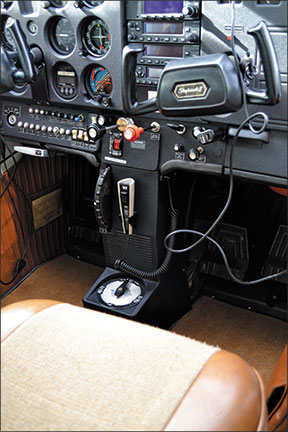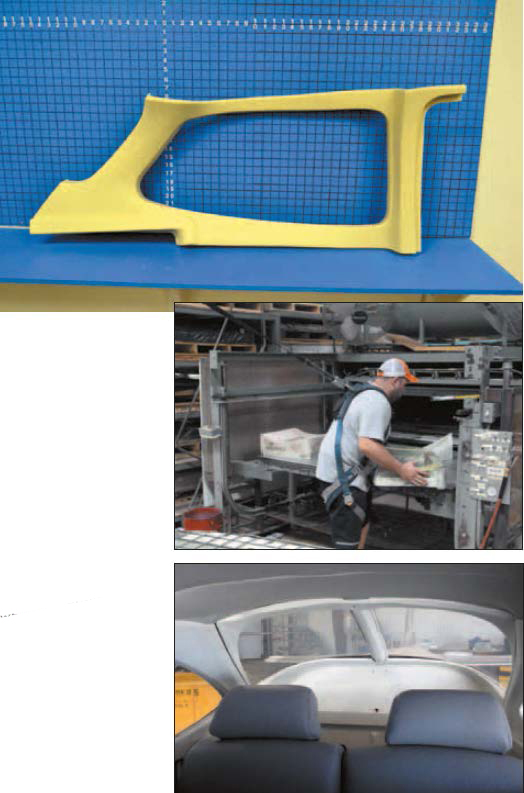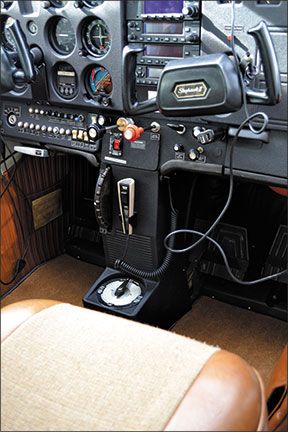Because of design, certification and insurance costs, the OEM industry is hobbled with a rather arcane system of pricing replacement parts. When it comes to interior plastic parts—like a window molding, hinge cover or a glove box overlay, for example—a couple of dollars’ worth of plastic becomes a $400 part simply because of its unique shape and application.

Fortunately, there are several smaller companies that can design, fabricate and sell certified parts for much less than an OEM. In fact, it’s not uncommon for an OEM to buy parts from these replacement shops.
We covered certified fiberglass replacement parts in the February 2014 issue of Aviation Consumer and found that fiberglass costs more than plastic, it’s more resistant to damage and is easier to repair than plastic.
But don’t think that plastic parts are old technology and no longer viable. In most cases, plastic will get the job done and when used in areas that aren’t subjected to temperature, sunlight or heavy usage, can be a viable long-term option. But replacing plastic components won’t come without some challenges. Here’s a look at the market and what to expect in your search.
Plastics 101
For the most part, plastic will be ABS or Kydex. Kydex—a combination of acrylic and PVC plastics—was developed in 1965 purely for the intent of making aircraft interior parts. Kydex is highly flame retardant and might be required by an OEM for initial installation. Kydex has different finished textures and comes in colors. It’s also expensive, so most aftermarket shops keep the price down by using other forms of sheet goods.
PVC or Poly-vinyl Chloride is a tough material. This toughness, combined with the flexibility and malleability of Acrylic lends itself to the thermal forming of complex parts, both large and small. PVC is resistant to a number of chemicals, can be finished with different textures and colored with paints that use a flex agent. PVC is made in Bloomsburg, Pennsylvania, and comes in sheets in a number of colors and thickness. Few parts are made with PVC, but it can be found.
The most popular interior plastic is ABS, or Acrylonitrile Butadiene Styrene. ABS is an extremely tough, formable plastic and it gets a high gloss when worked at the right temperature. Available in a few colors, Cessna and Piper originally used all ABS for its trims and fairings. When painted and ultraviolet-protected, it can last for 15-20 years. While resilient, ABS will support flame under high temperatures.
Big dogs
There are three main producers of aftermarket plastic parts, plus a few smaller shops around the country that make a limited number of items for less popular models. We will present overviews of the major providers and their pedigrees so you’ll know where to start in your search.
If you must have an OEM original, Preferred Airparts sells new surplus Cessna parts for a slight discount over factory new prices. Speaking of OEM parts, it’s not uncommon to pay a 50 percent price premium for them over aftermarket replacements. The advantage, however, is OEM parts should provide a perfect fit without trimming or drilling mounting holes. But you’ll likely face long lead times because OEM parts are generally made in batches, with intervals between production runs.

A couple of outfits claim to specialized in interior plastic components for certain aircraft makes. Two of these are PAST, a major supplier of Piper replacement parts, and Texas Aeroplastics, specialize in Cessna applications.
PAST, which used to be Heinol and Associates, was run by Al Heinol, a guy with a rich background in tool and die manufacturing for the automotive industry. Many of the older plastic steering wheels on American-made cars were produced on the tooling developed by Al Heinol. Heinol was known to make parts that had an accurate and quality fit. The Heinol parts catalogue focused on a wide variety of Piper applications, including the Aerostar and Navajo. The plastics manufacturing community has countless stories of Heinol’s love/hate relationship with the FAA (he loved to hate them, we’re told). In early 2013, the company was purchased by Alva, Oklahoma-based Premier Aerospace Service and Technology (PAST) and is becoming one of the major players in the aircraft interior parts business.
Scott Brown, PAST’s president, was once the president of Vantage Plane Plastics before aggressively pursuing the parts vending for the OEM industry and today supplies a number of parts to major manufacturers. The purchase of Heinol is an effort to keep the crew working between aftermarket supply and production runs for Cessna. At the same time, the company is building a larger inventory of Cessna replacement parts.
The Heinol buyout was typical of a company that wants to be aggressive, wants to enter a market with proven products and importantly, reap the benefits of having the legwork already in place. Consider that Heinol owned the tooling and inventory for scores of Piper parts, and more importantly, the paperwork that made them legal to install in aircraft. That’s a huge benefit for the consumer in terms of availability and costs.
The FAA requires sizable hoop-jumping when it comes to PMA parts and the STC that permits a legal installation. The PMA and the STC are treated separately, each with its own set of requirements and each handled in a different office. This creates an interim during which only completed, certified parts can be sold by the new company. PAST was surprised to find out that only a few of the 235 part numbers Heinol offered were actually legal. These days, along with making OEM parts for Cessna, PAST is busy acquiring certification for over 700 part numbers (in batches), developing its own manuals, storage, inventory and manufacturing areas, materials and techniques for the PMA approval. Interestingly, OEM manufacturing entails no FAA involvement or inspections.

Founded in 1981 by Jerry Evans, Texas AeroPlastics has been building Cessna interior parts for 33 years. While the company has downsized to a skeleton crew and moved to a smaller shop on the Northwest Regional Airport in Roanoke, Texas, the operation is efficient. As the name implies, Evans focuses on aftermarket Cessna parts and has partnered with different shops over the years to share information and better the fit and quality of the parts. The company fabricates its parts exclusively with ABS plastic and most parts are painted for UV protection. Besides the inventory of certified parts, the company sells maintenance items, lighting products and a leading-edge STOL kit.
Alva, Oklahoma-based Vantage Plane Plastics originated in 1961 as Kinzie Products. As a Hughes helicopter repair station, it began manufacturing its own parts—and learning the tricks of certification—when certain helicopter parts were unobtainable.
In the early 1980s, the company bought a Cessna 207 and found there were limited sources for aircraft interior parts, so it began building them itself. It accumulated a parts inventory of 3500 interior and exterior parts and is still growing. The plastic division of the company began in 1999 as Plane Plastics. Needing more technical and financial resources, it was sold to Vantage in November 2000. In 2005, the company built a new facility in San Diego, California.
Vantage builds parts for Boeing and other major airframe manufacturers, in addition to the U.S. military. The Vantage division of Plane Plastics is autonomous and managed by Mark Severs, a lifelong manufacturing expert, and Dale Logsdon, an A&P mechanic with IA privileges. The company employs only 18 people and 15 of them work in production.
It’s said that Plane Plastics is the big dog in the aircraft plastics yard because it can produce replacement plastic for nearly every general aviation aircraft out there. It continues to acquire pieces that will eventually make it into the inventory. To date, the Plane Plastics catalog has roughly 3500 parts and there are another 350 parts currently submitted for PMA and STC certification.
The company has a vast mold inventory. When we visited the facility, we saw row after row of 20-foot-tall shelving that’s dedicated to housing an inventory of 200 most popular replacement plastic parts. To better maintain stock, each part is bar-coded and a computer automatically schedules a production run when the supply gets low.
Plane Plastics offers its parts in three colors and the parts themselves are made of thicker plastic than the plastic material used by an OEM, but
there’s a tradeoff.
Thicker plastic can create a tight fit during the installation process, but the parts seem more robust and sturdy. The primary material used is ABS, but some parts are made of Kydex. The company website has a section showing how to measure and duplicate holes and is a good source for searching part numbers.
It’s important to note that color choices will be limited for most aftermarket plastic components. That’s a problem if you are trying to match the rest of the plastic or interior coloring of vintage aircraft. This means you’ll be faced with the additional task of painting the parts. Several suppliers told us the best long-term option is to apply vinyl dye to white or almond-colored parts. The soaking dye lasts longer and won’t dull the plastic finish.
inherent variations
Many parts will require placards that you’ll need to source on your own. We noted that Plane Plastics includes placards on a Cessna pedestal/trim housing. Of the parts we looked at, some are thin and some are made of thicker plastic sheets. When a thickness is chosen, it is based on the so-called draw, or how much the materiel will have to stretch when vacuum-formed over a mold.
A minimum thickness is important for both appearance and longevity. While thicker parts seem more robust, an entire interior replaced with the thickest sheeting can weigh up to 25 pounds more than the original parts. Cessna was notorious for producing extremely thin parts, but that helped with achieving a more favorable useful load. We suggest revising the aircraft weight and balance data after replacing all or most of the interior plastic. In some cases, it’s a good idea to have the aircraft weighed.
We discovered an interesting tidbit during our research. Mark Severs, who worked at Boeing, explained the discrepancies in part sizes that often lead to warranty work. A 747, if built to maximum tolerance in the fixtures, will have an extra row of seats compared to the same plane built to minimum tolerances. That’s a three-foot difference in cabin size. Severs explained that scaled down, it is not unusual for a Cessna or a Piper to be a half-inch longer or shorter. This can often be a problem when fitting aftermarket plastic parts.
To keep tabs on the fitment of its parts, Plane Plastics has a few airplanes in its hangar that it will randomly fit parts on to make sure the molds aren’t changing dimension. In addition, they’ll perform a factory installation at the owner’s request. Other shops have other ways of ensuring proper fit, often rebuilding parts while having the ill-fitting part in hand.
At most shops, a lot of time is spent repairing or upgrading molds. Different materials and resins have been used to make molds and while some hold up, others do not. In the old days, wood was used, but over time it expands and contracts with temperatures and ultimately cracks. Plaster was another medium, but it’s quite heavy and can shrink .
Some molds were made of aluminum, but when a hot part contacts cold aluminum, it immediately cools, deforming the part. New resins eliminate much of this and hopefully the repairs that become necessary for a proper fit during installation.
certification matters
Occasionally, a shop will have a part that is pending FAA certification and will sell this as a so-called owner-supplied part, while noting that the certification is missing. It’s up to the owner to install the part or a mechanic to note it’s an owner-provided part—an avenue taken by all of the plastic suppliers. Al Heinol used it like a magic wand. Despite having a non-certificated status, many of Heinol’s parts were arguably the nicest in the industry thanks to his tooling background.
This brings to question the necessity of requiring certification on cosmetic parts, save for burn testing. Many argue that cosmetic parts are as detrimental to an aircraft’s airworthiness as a headset is. Thankfully, a farsighted FAA has allowed for out-of-production parts to be used without certification if the owner provides instructions for making the part, proves its fit and function and signs off the installation in the aircraft logbook. Sending the old part to a manufacturer for use as a pattern qualifies the fit and function process.
Of the shops we visited, we think Plane Plastics is the size and volume leader, plus it has a resourceful web-site. PAST is growing into the number two slot for parts availability. All of the suppliers said that if they don’t have a part, they know who does and will lead customers to the source. That’s a welcomed gesture.


